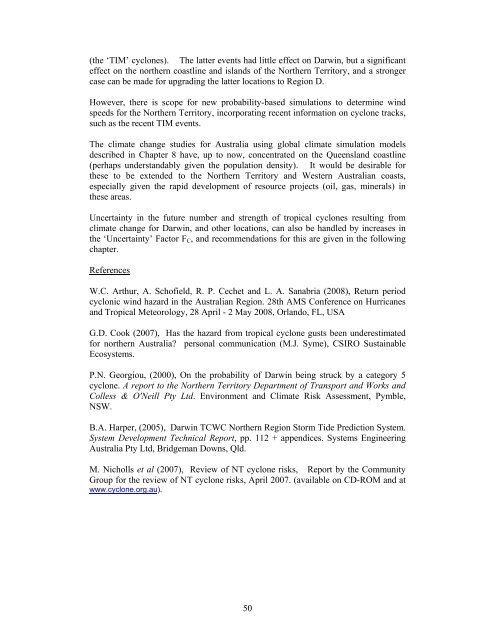PDF | 2 MB - Australian Building Codes Board
PDF | 2 MB - Australian Building Codes Board
PDF | 2 MB - Australian Building Codes Board
Create successful ePaper yourself
Turn your PDF publications into a flip-book with our unique Google optimized e-Paper software.
(the ‘TIM’ cyclones). The latter events had little effect on Darwin, but a significant<br />
effect on the northern coastline and islands of the Northern Territory, and a stronger<br />
case can be made for upgrading the latter locations to Region D.<br />
However, there is scope for new probability-based simulations to determine wind<br />
speeds for the Northern Territory, incorporating recent information on cyclone tracks,<br />
such as the recent TIM events.<br />
The climate change studies for Australia using global climate simulation models<br />
described in Chapter 8 have, up to now, concentrated on the Queensland coastline<br />
(perhaps understandably given the population density). It would be desirable for<br />
these to be extended to the Northern Territory and Western <strong>Australian</strong> coasts,<br />
especially given the rapid development of resource projects (oil, gas, minerals) in<br />
these areas.<br />
Uncertainty in the future number and strength of tropical cyclones resulting from<br />
climate change for Darwin, and other locations, can also be handled by increases in<br />
the ‘Uncertainty’ Factor F C , and recommendations for this are given in the following<br />
chapter.<br />
References<br />
W.C. Arthur, A. Schofield, R. P. Cechet and L. A. Sanabria (2008), Return period<br />
cyclonic wind hazard in the <strong>Australian</strong> Region. 28th AMS Conference on Hurricanes<br />
and Tropical Meteorology, 28 April - 2 May 2008, Orlando, FL, USA<br />
G.D. Cook (2007), Has the hazard from tropical cyclone gusts been underestimated<br />
for northern Australia? personal communication (M.J. Syme), CSIRO Sustainable<br />
Ecosystems.<br />
P.N. Georgiou, (2000), On the probability of Darwin being struck by a category 5<br />
cyclone. A report to the Northern Territory Department of Transport and Works and<br />
Colless & O'Neill Pty Ltd. Environment and Climate Risk Assessment, Pymble,<br />
NSW.<br />
B.A. Harper, (2005), Darwin TCWC Northern Region Storm Tide Prediction System.<br />
System Development Technical Report, pp. 112 + appendices. Systems Engineering<br />
Australia Pty Ltd, Bridgeman Downs, Qld.<br />
M. Nicholls et al (2007), Review of NT cyclone risks, Report by the Community<br />
Group for the review of NT cyclone risks, April 2007. (available on CD-ROM and at<br />
www.cyclone.org.au).<br />
50
















